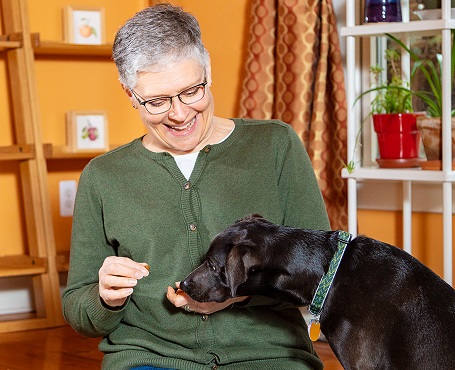Healthy Choices with Health Coach Liza Baker: Sweet Emotions

Sweet emotion
So far in this series on kicking the sugar habit, we’ve talked about the practice of crowding out, getting your calories from food rather than sugary beverages, and reading food labels in order to practice the rule of 5–10–10.
In some ways, the amount of carbohydrates we crave can be physiological: it’s driven by the amount of quick-release energy that our bodies need.
And there’s an emotional side to sugar cravings as well. (If you immediately got an earworm from the title “Sweet Emotion,” you must have grown up in the 70s, like me—you’re welcome!)
Primary + secondary foods
The Integrative Nutrition® concept of primary and secondary foods states that the food we put in our mouths is secondary to everything else in our lives that nourishes us (or doesn’t): career, relationships, physical activity, spiritual practice, sleep, time in nature…. The list really is endless once you start thinking of primary foods!
So in a sense, we can crave sweetness on the physiological level (sugar) and/or the emotional level: meaningful work for and with people we respect and admire, loving relationships, healthy movement, fulfilling spiritual practice, ample sleep, sufficient time in nature, etc.
Not surprisingly, when these primary foods “lack sweetness,” it’s easier to satisfy that craving for sweetness with food, which is in easy reach for most of us, than it is to find another job, leave a relationship, move our bodies more, develop a spiritual practice, get more sleep and time in nature.
It’s all well and good to talk about the best secondary food choices, but what if your primary foods are out of whack and you just can’t make the better choice most of the time or you can’t control (or you overly restrict) the amount of sweets you ingest?
Emotional eating
Have you ever considered how physical (physiological) and emotional hunger differ? It seems that for most of us who are privileged enough that we don’t need to concern ourselves with where our next meal is coming from, the majority of times we reach for food has little to do with physical hunger.
Emotional eating is best defined as using food for a purpose other than nutrition or satiety:
- Food becomes a coping mechanism for emotions you don’t want to feel.
- You employ food to feel better, self-soothe, numb, or fill a void.
- You use food to feel some sense of control.
If you tend to use food in one (or more) of these ways, it’s probably worth doing some work around emotional eating—because a disharmony in that area is often what is making your relationship with secondary food unhealthy.
As I like to say, if you hate your job, your boss is a jerk, and your coworkers drive you crazy, you are probably the one standing in front of the open freezer door emptying a pint of ice cream from the container—and no, all of the green kale smoothies in the world are not going to help you stop doing that.
Start with awareness
If you suspect you eat emotionally (also called “stress eating”), start with simply noticing your choices over the space of a few weeks—just noticing and noting them, preferably in a journal, whether it’s real or digital.
As you journal, consider these questions:
- When you face a particular choice, what was happening directly before you were faced with it? How were you feeling (physically, mentally, emotionally, energetically)?
- What did you choose to do, and how did you feel while you were doing it?
- How did you feel afterwards?
The first pattern to identify is what is going on when you experience hunger.
Physical + emotional hunger
The differences between physical and emotional hunger are fascinating, and some are probably more familiar than others.
Physical hunger
- Physical hunger arises gradually in response to your body and indicates that you are connected to your body’s signals.
- It can (eventually) be satisfied, so we stop eating when we’re full.
- Taking action on it—eating—can be delayed if necessary.
- It’s satisfied by a wide variety of foods: you look in the fridge and everything looks good!
- It doesn’t spark negative feelings before, during, or after you eat.
Emotional hunger
- Emotional hunger starts suddenly in response to the mind/emotions and indicates a disconnection from your body’s signals: you are ignoring your body’s message that it’s full—or at least it’s not hungry.
- It feels insatiable: you aren’t able to stop eating even when your body signals that it’s full.
- It wants instant gratification: you want it, and you want it NOW.
- It makes you crave specific foods or food combinations: you look in the stocked fridge, and nothing in there will do.
- It’s often accompanied by feelings of guilt, shame, or powerlessness.
Knowing those differences, catch yourself when you’re reaching for sweets and try to figure out why you’re eating—how you’re hungry. You don’t have to stop eating the food you’re reaching for—just notice whether it’s from physical or emotional hunger.
Next month, we’ll dig into next steps around emotional eating; in the meantime, download this handy reference to physical and emotional hunger and track your hunger using this worksheet—and let me know by email what patterns you identify!
Want to get started more quickly? Sign up for an intensive program on emotional eating—we’ll be creating a detailed roadmap for a way out in June/July of 2021!
WLAA health columnist Liza Baker is a health coach, cookbook author, blogger, podcaster, nonprofit consultant, and woefully underpaid COO of a busy family of four spread across the globe. Liza lives in a half-empty nest in Ann Arbor and is passionate about health and happiness, education and empowerment, SOLE/SOUL food and social justice.

























